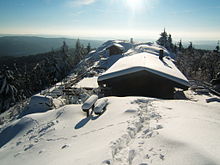Ruprechtsburg Castle
Ruprechtsburg Castle (also Rupberg Castle , older castrum Rupberck ) is the name of an abandoned castle between today's Zella-Mehlis and Steinbach-Hallenberg in today's Schmalkalden-Meiningen district in Thuringia .
The castle, called castle in an old document, was already owned by its owner, the monk Gebhard von Nordeck († February 1, 1115 or January 28, 1120), son of Thimo von Nordeck (the Henneberger ) and at the beginning of the 12th century of Hildegard of Thuringia (daughter Louis the Bearded and widow of Poppo I of Henneberg ) torn down. A castle from the middle of the 10th century is assigned to the Ruppberg, which Thimo von Nordeck is said to have owned at the end of the 11th century.
Gebhard, who lived a few years earlier as a monk in the Benedictine monastery Goseck founded in 1053 , the monastery Cella St. Blasii (nucleus of the later Zella , part of today's town Zella-Mehlis ) and churches in the area around Zella-Mehlis are to be made from the bricks of his own castle (in Albrechts and Heinrichs ). This is also made clear by a document dated May 14, 1112, in which Bishop Erlung von Würzburg confirmed that he had consecrated the oratorio St. Blasii in Zella , which Gebhard had given the Reinhardsbrunn monastery ( home monastery of the Ludowingers ) and the surrounding forest.
Assumed location

Since only a few documents have been recorded and no archaeological investigations have been carried out to date, the exact location is difficult to determine today. In general, in the castle literature, Ruppberg ( 50 ° 41 ′ 3 ″ N, 10 ° 38 ′ 21 ″ E ), located north of Zella-Mehlis, was and is assumed to be a high medieval castle in the remains of a Celtic fortification, which was also interpreted and can only be grasped in relief . Although no structural remains of the castle have survived, the castle is in the central location and because of the ability to control several old roads or trade routes (from the west from the Rhön , from the southwest from the Grabfeld over the Schwarza and Hasel valleys , from the south towards Hildburghausen / Schleusingen , from the north to or from the Oberhofer Pass) assumed here. There are several legends about the mountain and the lost castle , the best known are those of the treasure under the castle ruins and that of the enchanted knight's maiden , the white maiden and the charcoal burner .
However, the Lerchenberg ( 50 ° 39 ′ 33 ″ N, 10 ° 39 ′ 56 ″ E), located directly south of Zella-Mehlis, could also be considered as a location. There are still remains of ramparts, wall remains and the former castle path . From 1500 to 1840 an existing tower was used as a night watch tower for a fire watch . The tower was closed in 1840 due to its dilapidation.
See also
literature
- Hans Patze , Peter Aufgebauer (Ed.): Handbook of the historical sites of Germany . Volume 9: Thuringia (= Kröner's pocket edition . Volume 313). 2nd, improved and supplemented edition. Kröner, Stuttgart 1989, ISBN 3-520-31302-2 , p. 496.
- Michael Köhler: Thuringian castles and fortified prehistoric and early historical living spaces , 2nd exp. and revised Edition. Wittenberg and Leipzig 2003, ISBN 3-910141-57-9 . P. 243
- Cyriacus Spangenberg : Hennebergische Chronica: Der Vralten Loblichen Grauen vnd Furste [n] zu Henneberg Genealogia Stammenbaum vnd Historia . Jobin, Strasbourg 1599. pp. 144 f. ( Online edition )
- Tobias Weller: The marriage policy of the German nobility in the 12th century , Böhlau Verlag, Cologne / Weimar / Vienna 2004, ISBN 3-412-11104-X , p. 584 f.
- Eilhard Zickgraf: Die Fürstete Grafschaft Henneberg-Schleusingen: History of the Territory and its Organization , Volume I, Verlag NG Elwert, Marburg 1944, p. 56 f.
Web links
- Steinbach unter Hallenberg, History of a Hessian-Thuringian City (PDF document, 1.41 MB), therein Die Burg auf dem Ruppberg , p. 23 ff.
- Entry on Ruppberg Castle (Nordeck) in the private database "Alle Burgen". Retrieved April 18, 2016.
Individual evidence
- ↑ a b c Hans Patze: The emergence of the rule of Thuringia , Böhlau Verlag, Cologne / Graz 1962, p. 170
- ↑ a b c Hessian Memories, Volume 1, page 19
- ↑ cyriacis Spangenberg: Hennebergische Chronica , p. 145
- ↑ Heinrich Döring: The Thuringian Chronicle: With an introduction by Ludw. Bechstein . G. Froebel (printer), Erfurt 1841, p. 188 ( limited preview in Google Book search).
- ↑ a b Köhler: Thüringer Burgen , p. 243
-
↑ In the documents of the Goseck monastery, Hildegard is assigned contradictingly, what is worked out in the book by Hans Patze; see. also later family tables on European history:
- Detlev Schwennicke: European Family Tables , New Series, Volume I., Frankfurt am Main 1998, Plate 145
- Andreas Thiele: Narrative genealogical family tables on European history , Volume I, Part 1, RG Fischer Verlag, Frankfurt am Main 1993, Plate 178
- Detlev Schwennicke: European Family Tables , New Series, Volume I., Frankfurt am Main 1998, Plate 145
-
↑ Hans-Joachim Köhler, Almut Reissland (ed.): Zella St. Blasii, Mehlis, Zella-Mehlis: Contributions to History (1112 - 2012; 900 years Zella St. Blasii) , Zella-Mehlis 2012, therein:
- Ingrid Reissland: Gebhard von Nordeck as the founder of the Cella sancti Blasii pp. 12–26
- Johannes Mötsch: On the context of the first documentary mention of Zella St. Blasii , pp. 27–31
- Ingrid Reissland: The Cella sancti Blasii - Foundation, location and buildings , pp. 32–36
- Ingrid Reissland: Gebhard von Nordeck as the founder of the Cella sancti Blasii pp. 12–26
- ↑ Legends & Stories www.ruppberg.de website of the Ruppbergverein Zella-Mehlis eV , accessed on April 18, 2016

